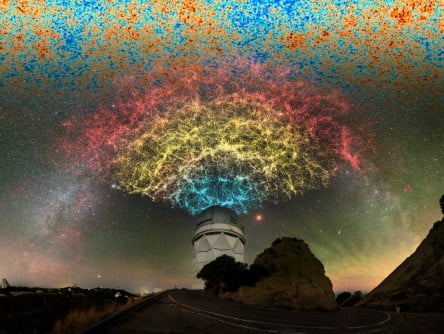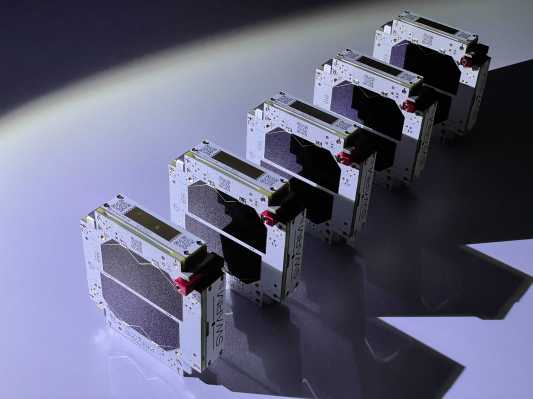The Dark Energy Spectroscopic Instrument (DESI), a cutting-edge astronomical survey, has been making significant strides in its quest to create the largest and most detailed 3D map of the Universe ever.
Since its launch in 2021, DESI has been observing an astonishing 5,000 new galaxies every 20 minutes, totaling more than 100,000 galaxies per night. The data collected during the survey’s first year has allowed astronomers to measure the Universe’s expansion history over the last 11 billion years with unprecedented precision, confirming our best model of the Universe while also uncovering intriguing areas for further exploration.
DESI, an international collaboration of over 900 researchers from more than 70 institutions worldwide, is managed by the U.S. Department of Energy’s Lawrence Berkeley National Laboratory (LBNL) and primarily funded by the Department’s Office of Science. The instrument is mounted on the U.S. National Science Foundation Nicholas U. Mayall 4-meter Telescope at Kitt Peak National Observatory, a Program of NSF NOIRLab.
To create its 3D map, DESI collects light from millions of galaxies across more than a third of the entire sky. By analyzing the spectrum of colors from each galaxy, DESI can determine how much the light has been redshifted, or stretched to a longer wavelength, due to the expansion of the Universe during its billions of years of travel before reaching Earth. The higher the redshift, the further away the galaxy is.
“The DESI instrument has transformed the Mayall Telescope into the world’s premier cosmic cartography machine,” says Pat McCarthy, Director of NOIRLab. “The DESI team has set a new standard for studies of large-scale structure in the Universe. These first-year data are only the beginning of DESI’s quest to unravel the expansion history of the Universe and they hint at the extraordinary science to come.”
One of the key features DESI has been studying is Baryon Acoustic Oscillations (BAO), the leftover imprint of pressure waves that permeated the early Universe when it was a hot, dense soup of subatomic particles. As the Universe expanded and cooled, these waves stagnated, freezing the ripples in place and seeding future galaxies in the dense areas. DESI’s detailed map shows strands of galaxies clustered together, separated by voids where there are fewer objects.
To measure the BAO pattern at greater distances, astronomers use the ‘shadow’ of the pattern as it’s backlit by extremely distant, bright galactic cores known as quasars. DESI has collected the largest set of quasars ever used for this type of study, totaling 450,000 objects. By mapping nearby galaxies and distant quasars, astronomers can measure the spread of the ripples across several periods of cosmic history to see how dark energy, the mysterious force causing the Universe’s expansion to accelerate, has stretched the scale over time.
“We’re incredibly proud of the data, which have produced world-leading cosmology results,” said Michael Levi, DESI director and LBNL scientist. “So far we’re seeing basic agreement with our best model of the Universe, but we’re also seeing some potentially interesting differences that could indicate dark energy is evolving with time.”
While the expansion history of the Universe may be more complex than previously thought, confirmation of this must await the completion of the DESI project. By the end of its five-year survey, DESI plans to map over 3 million quasars and 37 million galaxies, further improving the precision of its measurements.
The DESI collaboration is currently investigating potential upgrades to the instrument and planning to expand their cosmological exploration into a second phase, DESI-II, as recommended in a recent report by the U.S. Particle Physics Project Prioritization Panel. Data from DESI’s survey will work harmoniously with future sky surveys conducted by Vera C. Rubin Observatory and the Nancy Grace Roman Space Telescope, with each instrument’s strength complementing the others.
As DESI continues its groundbreaking work, astronomers eagerly await the insights it will provide into the nature of dark energy and the expansion history of our Universe. The exceptional results yielded by the NSF Mayall telescope with DOE DESI will undoubtedly drive cosmology research for many years to come.
Related
The material in this press release comes from the originating research organization. Content may be edited for style and length. Want more? Sign up for our daily email.





















































![Fear the Walking Dead Recap: Season 7, Episode 14 — [Spoiler] Kills… Fear the Walking Dead Recap: Season 7, Episode 14 — [Spoiler] Kills…](https://tvline.com/wp-content/uploads/2022/05/fear-the-walking-dead-season-7-episode-14-alycia-debnam-carey.jpg?w=620)




